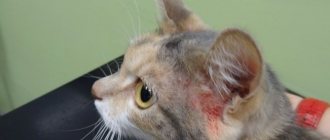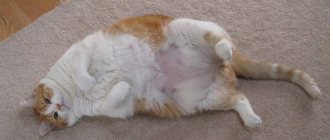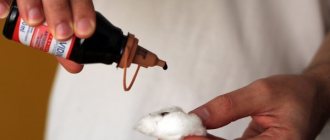Reasons why cats lose hair
Among the reasons that lead to a cat going bald at the tail are:
- various skin diseases. In such cases, the cat feels severe itching, which it cannot tolerate and scratches, thus combing out pieces of fur. Often large foci of the disease appear and are localized precisely on the tail, at its base. Here it is worth using different shampoos, drops and ointments to eliminate the problem and return the cat to a normal rhythm of life;
- oily seborrhea. These are disturbances in the functioning of the glands that produce fat necessary for the life of pets. If a lot of it is produced, then the hair falls out as a result of too oily skin. The opposite cases also occur when there is a lack of fat production. As a result of this, the skin dries out greatly, and hair also falls out profusely, primarily affecting the pet’s tail;
- dermatomycosis. This is a set of fungal diseases that are transmitted to a healthy pet literally in the first minutes of interaction with an infected individual. The cat's fur becomes weak, brittle, falls out a lot, bald spots appear on the tail and behind the ear, and on the back;
- Hair loss of a cat's tail also occurs due to diseases of the digestive system. There may also be vomiting and diarrhea;
- stress. Moving, a long trip, a change of environment or owners can cause a cat to shed its tail. This may also be accompanied by a lack of appetite, irritability, aggressiveness, weakened immunity and disruption of the functioning of the gastrointestinal tract;
- lack of vitamins. If severe hair loss and baldness on the tail are noticeable, you need to introduce vitamins and minerals into your pet’s diet to replenish the body’s reserves. First of all, these are: iron, calcium, phosphorus, potassium. Also, it is worth reviewing the cat's menu and perhaps changing it a little. An animal may suffer from a lack of vitamins during pregnancy or lactation;
- sterilization. After this procedure, it is quite possible that the cat’s hormonal levels will be disrupted, which will cause the tail to begin to go bald at the base. This is called endocrine alopecia.
Also, hair can fall out due to: allergies, lichen, tick bites, infectious parasites.
Veterinarians identify several reasons that can affect hair loss, which becomes significant and worries the owner:
- Seasonal shedding. This process may not cause concern if the hair loss is severe, but the cat does not experience discomfort. His nose is moist, his skin is clear, normal color, and there is no discharge from his eyes. If your cat has lost hair on her neck, this may be a sign of shedding. This is a natural and normal seasonal process. In pets, it can last for almost three months. This, of course, annoys the owners who have to remove scraps of fur. But new vegetation will grow to replace the old one, and we just need to help the process and promote its growth. This can be done by enriching the cat's nutritional diet with natural foods rich in minerals and vitamins.
- Diet. Nutrition has a significant impact on all body functions, as well as on the condition of the skin and hair. An unbalanced diet can lead to a condition that causes cats to lose hair profusely, especially on the back, tail, and neck. The rest may become dull. The most unpleasant thing for a cat can be redness, peeling and itching of the places where it fell out. This most often occurs when feeding a pet sausage, sausages, and in general foods high in fat, spices and salt. We also note the fact that a large amount of whole milk in an animal’s diet can cause hair loss.
- Hormonal disorders. Veterinarians note that often owners of animals who are given drugs that suppress attraction to the opposite sex complain that their hair is falling out a lot. In this case, wounds and ulcers may appear at the site of baldness. A change in the pet’s behavior was also noticed: lethargy, loss of appetite, as well as a change in body weight towards a decrease or significant increase.
- Allergic reactions. Cats are prone to allergies, mainly food ones. Certain products can cause hair loss and a number of unpleasant symptoms: inflammation of the ears, redness of the skin in areas of bald patches and severe itching that bothers the animal; the cat is constantly itching.
- Immune problems. A disease suffered by a pet and drug treatment can cause severe hair loss. But this is only a temporary phenomenon that will gradually pass when the body gets stronger.
- Facial alopecia. This term describes hair loss in cats between the eyes and ears. The process is natural and does not relate to the disease. It can appear in a cat between the second and third years of life.
We suggest you read: How to treat acne in cats? Treatment of acne on a cat's chin
What to do: how to help your pet
Having determined the diagnosis, the veterinarian prescribes treatment to restore the coat and remove the causes of hair loss in the cat.
Treatment methods:
- if the problem is allergic, the cat is protected from the allergen. Medicines are prescribed to boost immunity. If there is a food allergy, then the cat is put on a diet;
- skin lesions from mites and lice are treated with antiparasitic medications, including vitamins and nutritional supplements in the diet;
- if the bald spot occurs after an infectious disease, the veterinarian will prescribe a course of antibiotic therapy. Amoxicillin is usually prescribed.
- baldness due to stress is treated with sedatives (sometimes it is enough to simply eliminate the cause of this stress - that’s all);
- alopecia caused by demodicosis is treated by bathing with sulfur-selenium shampoo (1%);
- Ringworm is treated with ketoconazole, itraconazole, Griseovulfine, etc. In addition, it is recommended to use immunosupportive drugs, medications for better metabolism. Don't forget: ringworm is contagious;
- for endocrine disorders, hormonal medications are prescribed;
- abscesses are treated with local or systemic antibiotics and antiseptics.
Important! Use only products prescribed by your doctor. In this case, be sure to adhere to the permissible dosage.
Useful materials:
- Cloudy eye in a cat Common causes of cloudy eyes in a cat The most common causes of cloudy eyes are glaucoma, cataracts or keratitis.…
- Cutaneous horn General description of the disease Cutaneous horn on the forehead or face (ICD 10 code - L57.0) -...
- The cat's tail hurts Signs that the paws are failing The limbs are not always taken away suddenly, and there are cases when symptoms appear first...
- Itching and odorless discharge Main causesBefore considering the factors that provoke the appearance of discharge that has a sour odor, it is necessary to immediately note...
Treatment
First of all, the problem that caused the baldness to begin is eliminated.
If the loss is caused by an allergic effect, then this effect must initially be stopped. You may need to adhere to a dietary diet, eliminating many dishes and foods.
You can treat baldness of a cat's tail at home, if there are no serious reasons for this disease. But, of course, you need to consult a veterinarian for consultation, establishment of a diagnosis and receipt of all necessary recommendations and advice.
Sometimes, such a symptom, which symbolizes a disease, requires the use of antibiotics and other drugs. They fight the causes of the disease, stop hair loss and stimulate new growth.
Also, treatment consists of using: special ointments, drops, shampoos, anti-inflammatory and antihistamines, hormonal tablets, antiseptics, hydrogen peroxide and chlorhexedine, solutions and other medications. All this is used only as prescribed by a doctor.
Traditional medicine also enjoys good efficiency and effectiveness. It must be combined with taking medications to speed up the healing process. Bald areas of the tail can be lubricated with infusion of calendula and chamomile. Decoctions of yarrow and oak bark are effective.
Tail ulcer
Short-haired cats often suffer from ulcers that form on their tails. These ulcers can be located throughout the tail, including at the root of the tail, which can cause necrosis of the vertebrae of the caudal process.
This disease is specific and requires strict pharmacological treatment, as well as special recommendations to the owner for treating the cat at home. The process of treating a tail ulcer also includes cleaning it of dirt and, if formed, a crust. After this procedure, the affected area of the tail should be treated with antiseptic powder and lubricated with a special product prescribed by the veterinarian. Kubatol aerosol is often used for these purposes. After such treatment, the affected area is lubricated with ointment. This can be syntomycin or streptomycin ointment, or liquid Vishnevsky liniment. After treatment, the affected area of the tail should be wrapped with a light bandage for 5 days for protection.
All this time, you need to periodically comb the fur in areas located near the affected area to prevent itching. During the procedures, it is better to protect yourself with the help of a protective circle or a “plant pot” type muzzle.
Any tail disease can only be treated under the supervision of a veterinarian.
If this disease is neglected, your pet may develop gangrene. Therefore, when you first suspect the appearance of an ulcer, you need to take the necessary measures without delay. Otherwise, a situation may arise in which there is no other choice but to amputate the tail.
Skin diseases
The presence of diseases can also affect the condition of the cat's fur and its loss. Let's list the ones that often occur and cause severe loss.
- Skin mites. A skin lesion that is very unpleasant for an animal, causing discomfort with severe itching, rashes, and inflammatory phenomena that appear in areas of the skin affected by mites. You can recognize the disease by the first symptoms, which appear in the form of dull fur and bald spots on the face, ears and front legs.
- Fungal diseases (ringworm, mycosis). Having discovered the first signs of such lesions, you cannot take any measures on your own; immediately contact a veterinary clinic. We must remember that they are very dangerous for people. A sign of a fungal disease is that the hair falls out in round bald spots, which then form entire lesions. Inside them, scaly formations on the skin are noticeable. After diagnosis, the veterinarian will prescribe treatment, which must be strictly followed.
- Flea dermatitis. Flea saliva can cause an allergic reaction in cats. In addition to extensive hair loss, it can lead to severe redness and itching of the skin. With this disease, most often cats may lose hair on their back.
- Allergic dermatitis. Cats can react to irritants such as household chemicals, pollen, dust, etc. All these substances can cause quite severe allergies, which, in addition to hair loss, causes discomfort to the pet in the form of itching, redness of the skin, and the cat develops sores in areas where it is scratched.
- Psychological reaction to external factors. The sensitivity of cats to external stimuli is not new. Any phenomenon that causes stress in an animal can make the cat not only timid and even aggressive, but also encourage him to pull out his fur with his teeth in those areas where he can reach. This includes the stomach, the back, and the paws. At the same time, bleeding wounds and ulcers appear on bald skin, which can become a gateway for various infections.
- Seborrhea. This skin disease is characterized by particularly severe hair loss on any part of the body. The skin becomes inflamed, oily, and foul-smelling.
We suggest you read: Is it possible to cut the nails of Bengal cats?
Why does a cat go bald - reasons
01. The first reason is not at all terrible: it may be physiological reasons or seasonal changes in fur in especially fluffy individuals.
02. The second reason is adenitis. Most often it affects male cats. It appears as follows:
- crusts appear on the head and ears;
- the fur can be pulled out without causing pain or harm to the cat.
Since this disease is extremely rare, it is better to visit a veterinarian so that he can make an accurate diagnosis and prescribe treatment. While the case is pending, you can purchase a special detergent or shampoo.
03. The third reason is food allergies. Digestion in cats and cats occurs in a special way. Allergies can occur from any product.
Therefore, you should remember that you cannot share your food with your cat. It is better for her to purchase balanced food, with the necessary vitamins and supplements.
If circumstances force you to change food, it needs to be checked for the degree of digestibility, giving the pet a small amount. Read about how and what to feed your cat here.
04. The fourth reason may be injection. The fur will begin to fall off at the injection site. Gradually everything will fall into place; in this case there is no need to treat hair loss.
05. The fifth reason is seborrhea. Because of it, your furry friend suffers from peeling skin and spreads an unpleasant odor. You will have to have your blood tested at the veterinary hospital. Your veterinarian will recommend shampoo and fatty acids.
06. The sixth reason is lichen. To avoid this disease, you need to keep your cat clean. Well, if this happens, the doctor will prescribe medications.
07. The seventh reason is infestation with fleas or lice. It’s easy to get rid of them by using special hygiene products, but you should monitor your cat more carefully.
08. The eighth reason can be considered stress. When can a cat get it? Due to their personality traits, some animals may begin to go bald from stress during moving, changing housing, or participating in an exhibition. The cat is going bald on the hips, abdomen, and inner sides of the paws.
At this time, the pet needs increased attention and care. In addition, you should distract the animal from the constant desire to lick its fur, because in this case this procedure only provokes its loss.
09. The ninth reason is hormonal imbalance. Spayed or neutered animals may go bald due to hormonal imbalance. The cat behaves calmly. Treatment of baldness from this cause will be associated with taking hormonal medications, again prescribed by a doctor. The fur will be restored completely.
Fighting baldness in cats
Cat owners, having noticed changes in the animal’s hair, begin to panic and look for an answer to the question of what to do if the cat’s hair falls out. Different causes of hair loss require different treatment approaches.
The result of an unbalanced diet, accompanied by signs of partial baldness, for example, when a cat has flaking hair on its hind legs, is treated mainly with diet. Pets on dry food should receive enriched vitamin complexes, and those on a natural diet should receive low-fat foods with the addition of B vitamins. To relieve itching, antihistamines can be given in small doses no more than twice a day.
Dermatitis is quite difficult and time-consuming to treat, and treatment tactics are chosen exclusively by a veterinarian based on tests and the general condition of the animal. In most cases, drugs are prescribed in the form of ointments and gels, which are applied to the affected skin and have an anti-inflammatory effect.
Wool /
Prevention of baldness
To protect your pet from hair loss, including during illness, you must:
- carry out prevention against parasites (fleas, ticks);
- Visit your veterinarian regularly for a complete medical examination;
- do all vaccinations;
- properly balance nutrition;
- Observe the necessary hygiene measures (bathing, combing hair).
A good owner must constantly monitor the health of his pet and create all the necessary conditions for it. You should always remember that it is better to prevent any disease than to treat it.
About the importance of diagnosis
Let us immediately note that a correct diagnosis (that is, to understand why exactly the syndrome developed) can only be made in a good veterinary clinic with competent specialists and high-quality technical equipment.
It is impossible to understand the causes of the symptoms of the disease “on your knees.” The veterinarian must carefully collect anamnesis (starting from a very early age) and conduct a thorough examination of the pet. The matter is not limited to this: you need a complete neurological examination, an x-ray of the lumbar and sacral parts of the spinal column, and a complete blood test. In complex and doubtful cases, an MRI is urgently needed.
No matter how strange it may seem to the owners themselves, it is the anamnesis that sometimes helps to identify the true cause of the development of the syndrome. It is advisable for the owner to remember when and at what speed his pet began to develop signs of the disease.
The problem is that there are a lot of diseases that can lead to a “sagging” tail and other unpleasant effects, and some are difficult to distinguish from each other. Thus, an incorrectly healed fracture or an old injury must somehow be distinguished from a genetic developmental anomaly, and without the appropriate experience and equipment this is impossible
This is extremely important, since if you have a cauda equina, you need to start treatment immediately. Without a correct diagnosis, this is not easy to do.











